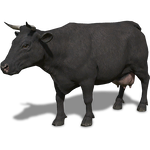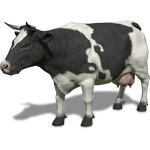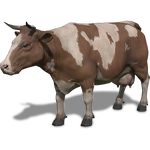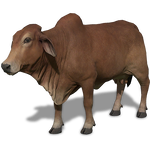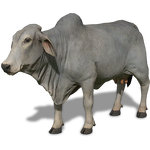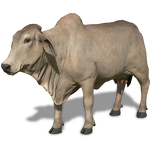Cows/Farming Simulator 19
Cows are a type of Animal in Farming Simulator 19. Cow husbandry requires plenty of money to start, but at full efficiency it can provide a large amount of money every day for relatively little work. In Erlengrat map in new farmer mode startup comes 10 cows (5 black & white with 5 brown & white).
Cows are fairly expensive animals, costing $2500 apiece (not including transportation costs). The smallest Cow Pasture available in the base game costs $100,000, and can hold up to 50 cows.
The primary product of Cows is Milk, which is created when cows are supplied with Water and any of three types of food. Milk production rates depend mainly on the type of food provided to them, with Grass giving the least Milk production, Hay or Silage giving mediocre production, and Total Mixed Ration giving the best production. Providing Straw to the cows and keeping their feeding area clean increases productivity even further.
At 100% productivity, Each cow should produce approximately 150 liters of Milk per day. Keeping animals at a exactly 100% productivity is extremely difficult, so Cows should be expected to produce around 135 liters of Milk per day under realistically-ideal conditions.
As by-products, Cows also produce Slurry from Water, and Manure from Straw. They do not need to be provided with any food in order to produce these materials at the maximum rate.
At 100% productivity, cows breed at a rate of one cow per 1200 hours (50 days) divided by the number of cows of the same color and breed in the same pen. Cows stop breeding if there is no room in the pen for more cows, or if they run out of food or water. Each cow sells for $2000 (not including transportation costs).
The base game provides 8 different types of cows, including 4 different colors of Common "Taurine" Cows and 4 different colors of American-bred "Brahman" Cows. All types of cows function identically, regardless of color or breed.
List of Cows
The base game provides 8 different types of Cows. These can all be bought at the Animal Dealer. There is no functional difference between any of the different types of cows, only physical appearance.
| Name | Price |
|---|---|
| Cow (black) | 2,500 |
| Cow (black & white) | 2,500 |
| Cow (brown) | 2,500 |
| Cow (brown & white) | 2,500 |
| Brahman (brown) | 2,500 |
| Brahman (grey) | 2,500 |
| Brahman (light brown) | 2,500 |
| Brahman (white) | 2,500 |
Cow Pasture
- Main article: Cow Pasture (Farming Simulator 19)
Before purchasing any Cows, you must purchase at least one Cow Pasture from the Store. This is a Placeable that can be placed on any sufficiently-large open space (no obstacles).
The base game provides two different models of Pastures. The only real difference between them is their capacity (the number of cows they can hold), and their physical size.
Once the Cow Pasture is placed on the map, you can begin to fill it with Cows and their required materials.
Purchasing Cows
To purchase cows, visit the Animal Dealer and interact with its sale point ![]() Open Animal DialogueDefault Buttons: https://vignette.wikia.nocookie.net/farmingsimulator/images/d/dd/FS17_Logo_PC.png/revision/latest/scale-to-width-down/30?cb=20170827234847 Rhttps://vignette.wikia.nocookie.net/farmingsimulator/images/6/6c/FS17_Logo_XBOX.png/revision/latest/scale-to-width-down/30?cb=20170827234910 LShttps://vignette.wikia.nocookie.net/farmingsimulator/images/e/e3/FS17_Logo_PS4.png/revision/latest/scale-to-width-down/30?cb=20170828002413 L3. This will only work if you own at least one Animal Pen, otherwise the menu will not work.
Open Animal DialogueDefault Buttons: https://vignette.wikia.nocookie.net/farmingsimulator/images/d/dd/FS17_Logo_PC.png/revision/latest/scale-to-width-down/30?cb=20170827234847 Rhttps://vignette.wikia.nocookie.net/farmingsimulator/images/6/6c/FS17_Logo_XBOX.png/revision/latest/scale-to-width-down/30?cb=20170827234910 LShttps://vignette.wikia.nocookie.net/farmingsimulator/images/e/e3/FS17_Logo_PS4.png/revision/latest/scale-to-width-down/30?cb=20170828002413 L3. This will only work if you own at least one Animal Pen, otherwise the menu will not work.
After pressing the button, if you have more than one Animal Pen, you'll be asked which pen you'd like to populate. You must select an existing Cow Pasture in order to purchase Cows. If you do not own such a Pasture, you will only be able to purchase other animals.
Production and Consumption
Cows can be provided Water, Straw, Grass, Hay, Silage, and/or Total Mixed Ration at their pen.
If provided with Water, cows produce Slurry.
If provided with Straw, cows produce Manure.
If provided with Food and Water, cows produce Milk. The rate of Milk production depends primarily on the type of food provided to them, with Total Mixed Ration giving the highest productivity. If Straw is available, Milk production is increased further. Keeping the pen clean increases it even more.
Consumption and production is processed at 15-minute intervals (in-game). The numbers below, however, indicate how much cows produce in one whole day (24 hours).
If cows have no materials available in their pasture, they will not produce anything nor will they breed. However cows will not die if they have no food or water.
Slurry
While any amount of Water is available in the Pasture, each Cow consumes 80 liters of Water per day and produces 250 liters of Slurry per day.
Slurry accumulates in an underground tank at the Cow Pasture, and can be taken using various Slurry Tankers or Slurry Spreaders. Slurry can then be sprayed on fields using a Slurry Spreader, and acts as a regular Fertilizer. This is a cheap and easy way to produce relatively large quantities of Fertilizer to replace store-bought fertilizers.
If you own the Biogas Plant, you can sell Slurry for $0.18 per liter, while also producing 0.3 liters of Digestate per liter of Slurry sold. This is essentially free profit, since you only need Water (which is free) to produce Slurry.
The rate of Slurry production per cow does not change for any reason, except if the Water in the pasture runs out (in which case no Slurry will be produced).
Manure
While any amount of Straw is available in the Pasture, each Cow consumes 95 liters of Straw per day and produces 200 liters of Manure per day.
Manure accumulates in a bunker next to the Cow Pasture. It can be loaded into various types of Containers and Manure Spreaders using a Loader or Conveyor Belt system. Manure can then be sprayed on fields using a Manure Spreader, and acts as a regular Fertilizer. This is a cheap and easy way to produce relatively large quantities of Fertilizer to replace store-bought fertilizers.
If you own the Biogas Plant, you can sell Manure for $0.18 per liter, while also producing 0.3 liters of Digestate per liter of Manure sold. This is about twice the value of the Straw required to produce the Manure.
The rate of Manure production per cow does not change for any reason, except if the Straw in the pasture runs out (in which case no Manure will be produced).
Milk
While any amount of Grass, Hay, Silage or Total Mixed Ration is available in the Pasture, along with any amount of Water, cows will consume the best available food and produce a certain quantity of Milk.
Each cow produces approximately 150 liters of Milk per day while at 100% productivity. While producing Milk, each cow consumes 350 liters of Food per day, starting with the best type of food available at the time (see below).
The Productivity value depend on the best type of food available in the Cow Pasture, as well as several other factors:
| Best Food Available | Productivity | Estimated Milk Production per Cow per Day (liters) |
|---|---|---|
| Grass | 20% | 30 |
| Hay or Silage | 60% | 90 |
| Total Mixed Ration | 80% | 120 |
If any amount of Straw is also available, Productivity is increased by 10%.
Additionally, productivity is increased by the current Cleanliness value of the Cow Pasture divided by 10.
Therefore, to get to 100% productivity, you must provide Total Mixed Ration, Straw, and keep the feeding area completely clean. Because keeping the feeding area completely clean is incredibly difficult, it is likely that your actual Productivity value will shift between 100% and 90%, assuming you clean the pasture once a day - giving an average productivity of only 95%.
Therefore, when the best food, as well as water and straw is provided to your cows, each cow will produce an average of around 142 liters of Milk per day.
Milk accumulates in the Cow Pasture and can be removed by placing a suitable Water Tanker in the marked area and filling it up. You do not need additional equipment to take the milk from the pasture. The tanker can then be taken to any of the Basic Sale Points on the map to sell the milk. Note that only two of the three available Water Tanker models in the base game can carry milk.
Breeding
As long as there is at least one Cow in a Pasture, that cow will multiply over time. New cows will appear automatically and be added to the other cows in the pasture. You can breed cows to increase your Milk production, or sell them for an immediate profit.
The rate of cow reproduction depends on how many cows of the same type are in the same Pasture, and the current Productivity rating for that Pasture (see prev. chapter).
At 100% productivity, cows reproduce at a rate of one Cow per 1200 hours divided by the number of cows of the same color and breed in the pen.
Example: Assuming 100% productivity, if you have 10 Brahman (brown) in a single pen, they will create one new Brahman (brown) cow every 1200/10 = 120 hours. If you also have 5 Brahman (grey) in the same pen, those cows will separately produce a new Brahman (grey) cow every 1200/5 = 240 hours.
As the Productivity drops, the base time to create a new cow increases exponentially:
| Productivity | Hours to Breed |
|---|---|
| 100% | 1200 |
| 90% | 1330 |
| 80% | 1500 |
| 70% | 1714 |
| 60% | 2000 |
| 50% | 2400 |
| 40% | 3000 |
| 30% | 4000 |
| 20% | 6000 |
(It is not possible to breed cows at under 20% productivity, as this implies at least one required material is completely missing).
Since it is virtually impossible to keep productivity at 100% constantly, expect a breeding time of between 1330-1200 hours per cow, divided by the number of cows of the same type.
Same Breed and Color
Note that the calculation above involves cows of the same breed and color. This has an important effect that makes it slightly better to keep multiple cows of the same breed and color in each pen, rather than mixing cows and breeds.
For example, if you have 8 cows of the same type, they will produce one new cow every X/8 hours (where X is the base breeding rate in the table above); whereas if you have 8 cows of different types they'll simply produce 8 new cows after X hours.
This is important, because in the first case the 9th cow will arrive after X/8 hours and increase the breeding rate, so the 10th cow will arrive after X/9 hours, the 11th cow will arrive after X/10 hours, and so on. In the second case, all 8 new cows arrive together after X hours, suddenly boosting the breeding rate. This means that cows breed faster when they are all of the same color and breed!
Here is a timeline of what happens in the game, assuming constant 100% productivity (all numbers are approximate):
| Hours Passed | Cows of Different Types | Cows of Same Type | ||
|---|---|---|---|---|
| Num. of Cows | Hours to Next Breeding | Num. of Cows | Hours to Next Breeding | |
| 0 | 8 | 1200 | 8 | 150 |
| 150 | 8 | 1050 | 9 | 133 |
| 283 | 8 | 917 | 10 | 120 |
| 403 | 8 | 797 | 11 | 109 |
| 512 | 8 | 688 | 12 | 100 |
| 612 | 8 | 588 | 13 | 92 |
| 704 | 8 | 496 | 14 | 86 |
| 790 | 8 | 410 | 15 | 80 |
| 870 | 8 | 330 | 16 | 75 |
| 945 | 8 | 255 | 17 | 70 |
| 1015 | 8 | 185 | 18 | 67 |
| 1082 | 8 | 118 | 19 | 63 |
| 1145 | 8 | 55 | 20 | 60 |
| 1200 | 16 | 600 | 20 | (5) |
As you can see, after 1200 hours the cows of the same breed have reached 20, whereas cows of different breed have only doubled their numbers to 16.
As the breeding speed increases for the cows of the same type, Milk production also increases more rapidly. Thus, the cows of the same type will have produced much more milk by the 1200th hour than the cows of different types! Similarly, they will also have consumed a lot more materials.

